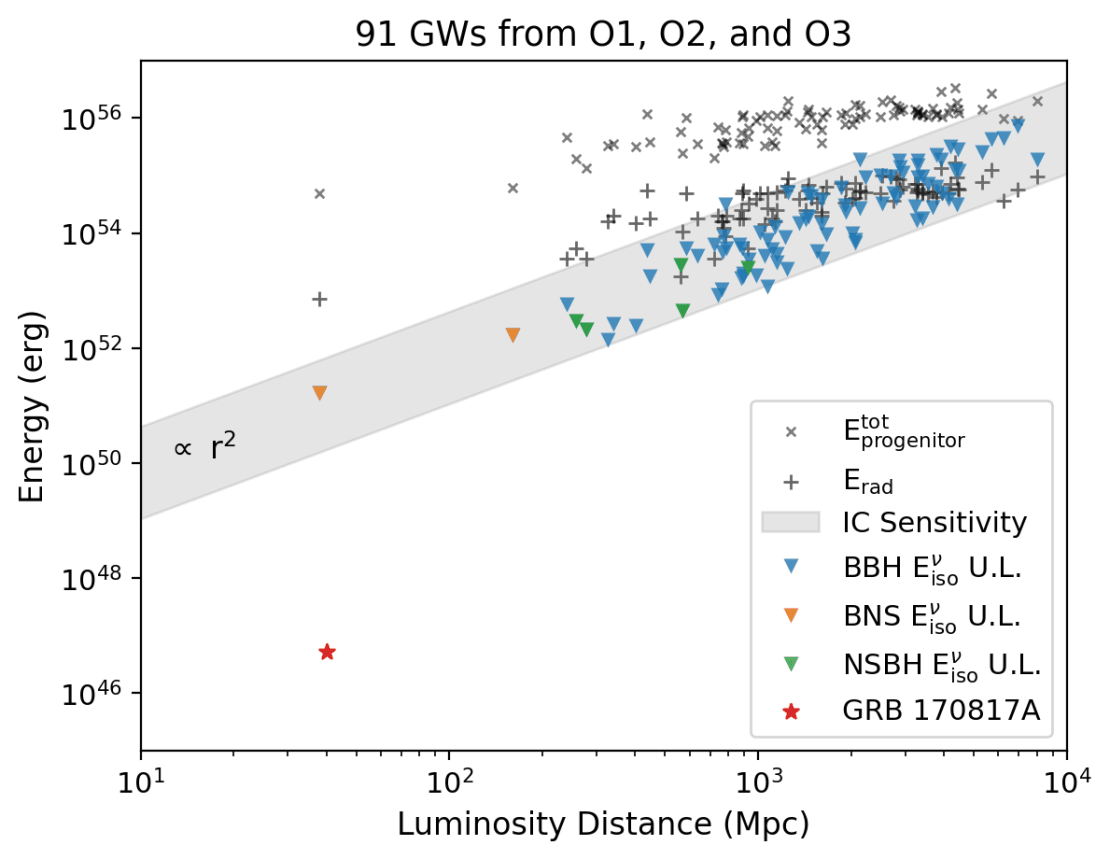Gravitational waves (GWs) are a signature for some of the most energetic phenomena in the universe, which cause ripples in space-time that travel at the speed of light. These events, spurred by massive accelerating objects, act as cosmic messengers that carry with them clues to their origins. They are also probable sources for highly energetic neutrinos, nearly massless cosmic messengers hurtling through space unimpeded. Because neutrinos rarely interact with surrounding matter, they can reveal phenomena that are otherwise unobserved with electromagnetic waves. These high-energy neutrinos are detected by the IceCube Neutrino Observatory, a cubic-kilometer detector enveloped in Antarctic ice at the South Pole.
Both GWs and neutrinos are recently introduced messengers in astronomy and have yet to be detected by the same source. Such a major discovery would not only shed light on the sources of cosmic rays but would also help in understanding the most energetic processes in the universe. By coordinating traditional observations (from radio to gamma rays) with these new messengers, researchers can gain deeper insights into astrophysical sources that were unobtainable before.
Previously, the IceCube Collaboration looked for joint emission of GWs and high-energy neutrinos with data collected by IceCube, the Laser Interferometer Gravitational-Wave Observatory (LIGO), and the Virgo gravitational wave detector. These results were from GWs observed during the first two observing runs (O1 and O2) of LIGO and Virgo. IceCube researchers from the University of Wisconsin–Madison and Columbia University conducted an updated analysis of GWs from the third observing run (O3) of the LIGO/Virgo detectors. The increased number of GWs improved the researchers’ overall analysis. Their findings were recently submitted to The Astrophysical Journal.

From 2015 to 2020, the LIGO/Virgo detectors have detected about 90 GWs resulting from compact binary mergers or orbiting pairs of massive objects, including binary neutron star, binary black hole, and neutron star-black hole pairs. Researchers ran a data analysis pipeline that searched for IceCube neutrinos that were coincident in space and time with respect to the GWs. The results of the neutrino searches were quickly reported in real time (typically within about an hour of the GWs reaching Earth)—an impressive feat by both the LIGO/Virgo and IceCube Collaborations—and off-line once the catalogs of candidate GWs were released by LIGO/Virgo.
“We used two methods to assign a statistical significance value to each gravitational wave and the set of candidate neutrinos that were detected in a time window, based on their localizations and detection times,” explained Doğa Veske, former physics PhD student at Columbia University and colead on the analysis. “The difference between the two methods is that one of them uses extra information based on what we physically expect for such events whereas the other one uses fewer assumptions.”
Although the researchers did not find significant evidence of neutrino emission by gravitational wave sources, they were able to put constraints on possible high-energy neutrino emission from GWs.
“One amazing thing about detecting GWs is that they carry enough information to directly measure the distance to the source,” said Justin Vandenbroucke, a physics professor at UW–Madison and colead on the analysis. “Because of this, we were able to calculate not only that the neutrino signal reaching Earth from these GWs must be below a certain brightness but also (using the measured distance to the source) that the total energy emitted by each source in neutrinos was below a certain level.”
Follow-up analyses are underway, including more real-time public reports to coincide with the upcoming fourth observing run (O4) where a new gravitational wave observatory, the Kamioka Gravitational Wave Detector (KAGRA), will join upgraded LIGO and Virgo detectors. Slated for a March 2023 start, O4 is expected to detect more GWs than before.
“With a more sensitive gravitational wave detector, it is expected that there will be more frequent observation of GWs,” said Aswathi Balagopal V., a postdoctoral associate at UW–Madison and colead on the analysis. “That means that we can have a better chance of finding joint sources of neutrinos and GWs.”
+ info “IceCube search for neutrinos coincident with gravitational wave events from LIGO/Virgo run O3,” IceCube Collaboration: R. Abbasi et al., The Astrophysical Journal 944 (2023) 1, 80, iopscience.iop.org, arxiv.org/abs/2208.09532.